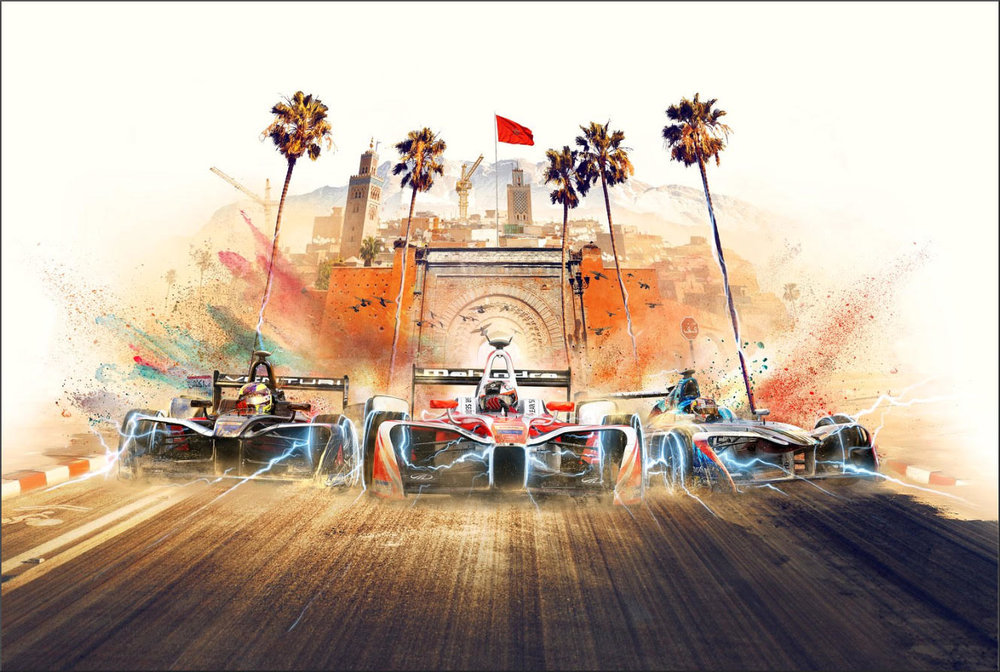
Crosby, Stills and Nash’s 1969 Marrakesh Express famously sung the praises of “Colored cottons hang in air, Charming cobras in the square, Striped Djellebas we can wear at home” and half a century later that image of Marrakesh as a city agreeably stuck in a touristic time warp remains. Which could not be further from the truth. Ten days ago I attended the Marrakesh ePrix at which the accompanying photos were taken. This is an international race for cars that superficially resemble their more familiar Formula One counterparts but which differ radically under the bodywork, because they are 100% electric powered.

Formula E, which races in many major cities including Hong Kong, New York and Berlin, is a laudable attempt by motor sport to clean up its environmental credentials. The standard objection that electric cars require fossil fuel to generate their electricity is overcome by using specially commissioned generators which run on glycerine, which is a byproduct of bio-diesel, to recharge the cars. The generators are transported with the cars and associated kit from race to race using transport that minimises the resulting carbon footprint. Other environmentally aware policies include limiting the number of team personnel at races and eliminating the lavish hospitality facilities that are a feature of Formula One. To cap costs and limit competitive advantage many parts are common to all cars, including the chassis (monocoque), bodywork and battery pack. View the highlights of the Marrakesh ePrix below.
The Noor Ouarzazate Solar Complex in the Moroccan Sahara came on stream in 2016 and when completed will be the world’s largest concentrated solar plant with the potential to power one million homes. Marrakesh has a fleet of Chinese-manufactured buses. Renault and Peugeot both plan to build electric vehicles in Morocco, as does Chinese corporation BYD which has a 13% share of the global electric vehicle market. One of the teams competing in the Marrakesh ePrix was NIO backed by the eponymous Chinese electric autonomous vehicle manufacturer, while the winning car came from the team of Indian auto and technology company Mahindra – see photo below.
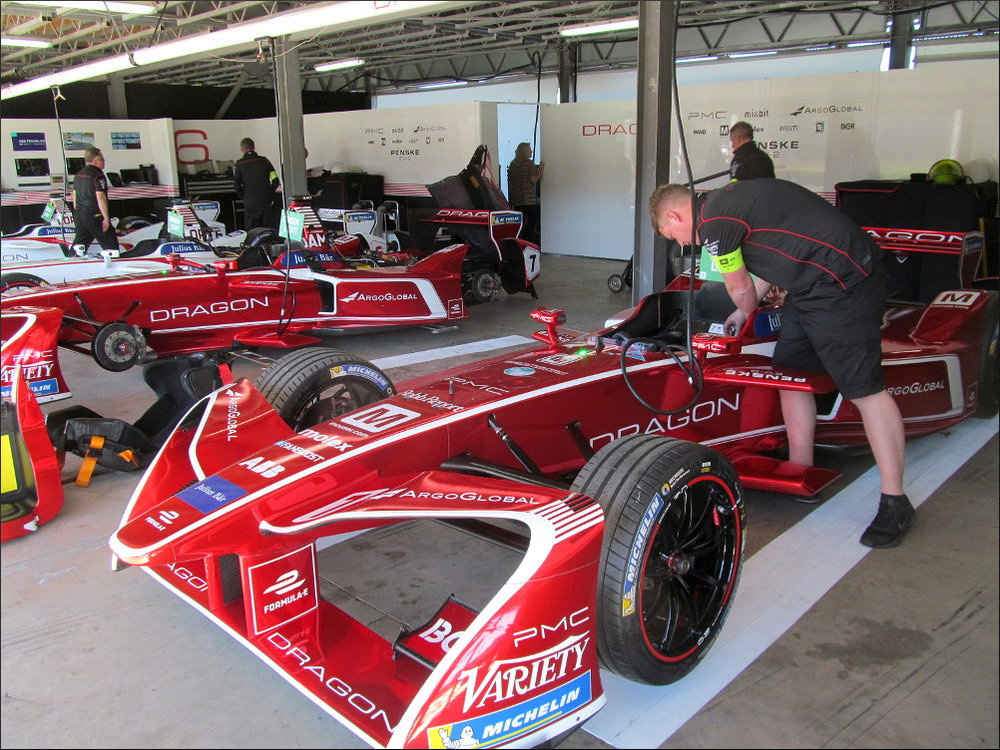
As can be seen in some of the photos, 52% of the Moroccan population is under 25 and they are raring to go places. Preconceptions about charming cobras in the square and about the perils of majority-Muslim nations need to be ditched before the West is caught napping. And it is not just the President of the United States who is guilty of damaging preconceptions about countries beyond Western comfort zones. While taking these photos a Moroccan boy of about ten tapped me on the shoulder and proffered a bottle of water. I waved him away brusquely, thinking he was an urchin trying to make a few dirhams by selling refilled bottles. But he persisted and finally explained by sign language that the bottle had fallen out of my daypack a few minutes earlier.
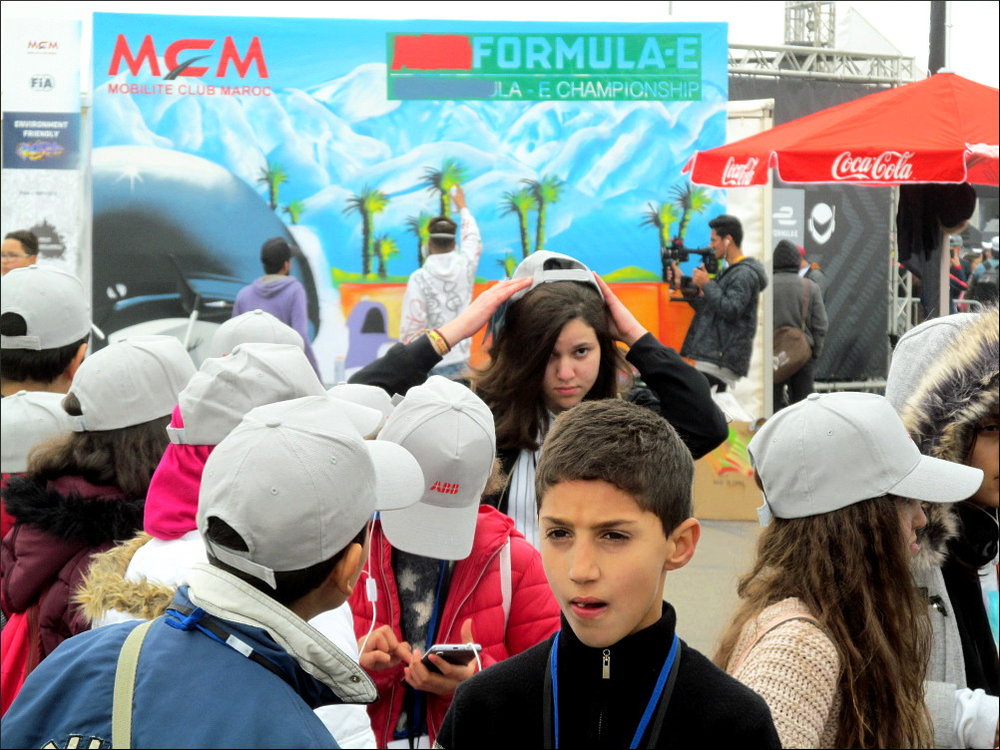
Some backround on Formula E
There are three structural components in a Formula E car. The monocoque from the front to the bulkhead behind the driver is from Dallara and is mandated — standard on all cars; as is the front suspension, all the bodywork including aerodynamic appendages and rear crash structure, and all four wheels and tyres. Behind the driver is the battery pack and control electronics which is a structural member. The battery pack and control electronics are also mandated and currently come from Williams Advanced Engineering. (Next season batteries with more capacity from McLaren Technologies replace the current pack.) Bolted on to the back of the battery pack is the motor(s), drive train (some cars do not have gearboxes because of the torque from an electric motor), and rear suspension, all of which is non-mandated — that is, proprietary – and varies from team to team. Some use single motors, some dual.
The battery pack is immensely powerful. Peak output is 200 kilowatts, which is a serious amount of power. This necessitates special safety requirements. Lithium batteries not only pack a punch but they also emit flames if pierced. So the inside of the battery pack is made of zylon which is 1.6 times stronger than kevlar. If you look closely at a car you will see a green light on ahead of the cockpit and an obscured green sign on the roll hoop which says ‘Green Light On’. This means the car is safe to touch. If any of the electronics go open circuit as a result of a crash the light turns red and the marshals must not touch the car until the electronics are made safe.
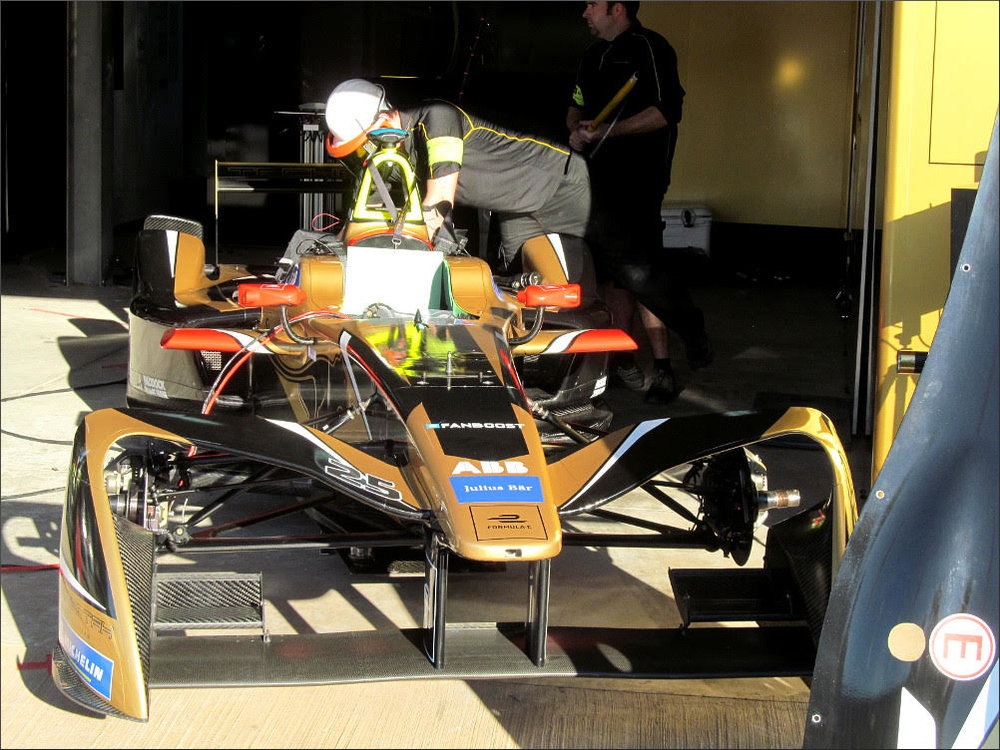
The photo above highlights the safety concerns graphically. Electrocution causes the hand of the person being shocked to lock — so if a mechanic gets 200kW through their hand they cannot let go of the car. In the photo the battery pack is being worked on. So not only is the mechanic wearing protective gear, but the rules require another mechanic to stand behind him with a yellow plastic hook — seen in the photo — which is used in the event of electrocution to literally drag the victim off the car.
They may not sound like racing cars but there is much of interest in a Formula E car, and I don’t think the story about them has been told very well.
Next year — season 5 — Formula E has a new ‘standard’ car from Dallara which is very futuristic. Spark is the French company that actually services the teams — provides the parts to Dallara’s specs. At Marrakesh one team shunted their car in qualifying and crushed the nose. The mechanic trotted off to the Spark shipping container/shop with a credit card and bought a new nose. They don’t paint the cars, the colour schemes are all vinyl wrap applied with a heat gun to fit it to contours. Note the season 5 car does not use the controversial ‘halo’ adopted by F1, instead it uses a raised windshield.
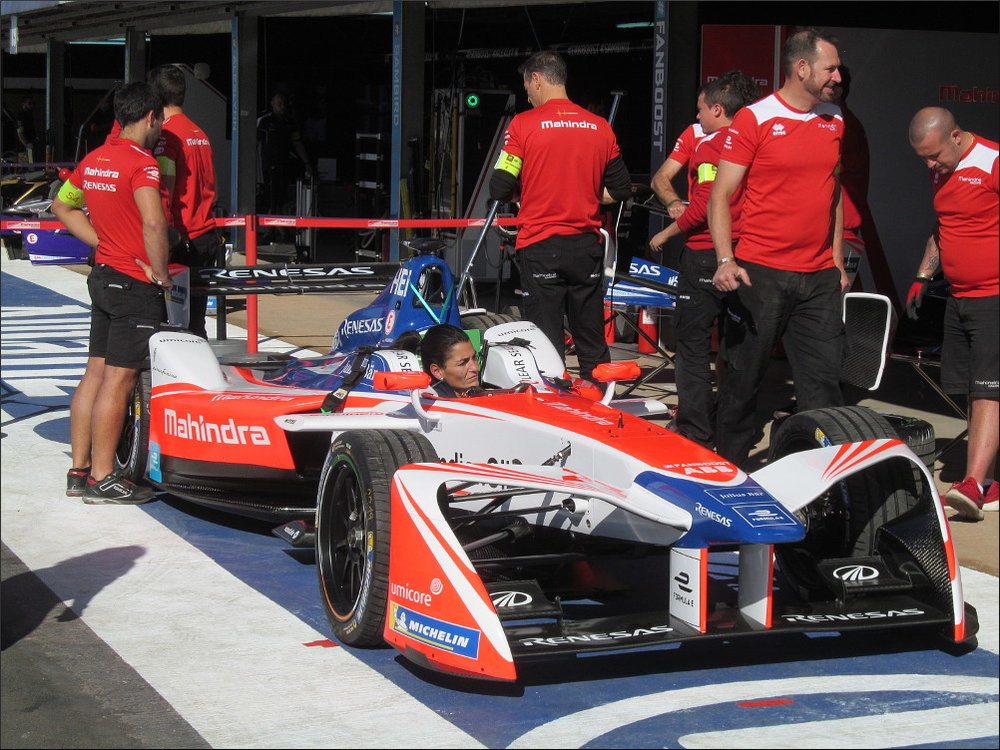
- You can find more from Bob Shingleton here. Bob is the brother of our regular contributor, John Shingleton. All the photographs in this article were taken not with a brother-John Leica X1 but an old Canon Powershot SX150 IS. As Bob says, “I still use it because it fits in my pocket and is good for discreet shooting. It also has the big advantage of using AA batteries. so I can just carry a stash of batteries and don’t have to worry about recharging.”

Coming soon, "Formula D".
The "D" stands for driverless, that will be fascinating, my company’s battery is bigger than yours.
Maybe I am just old and crotchety but I just don’t buy Scalextrics thing.
Bob,
Thanks for a really interesting article and pictures!
Kevin
Thanks Bob. I have been a long time fan of all types of motor racing, but with F1 getting more boring all of the time due to dominance by one make/driver, I did look at some Formula E races last year. One of the most exciting aspects last year was the change of cars once batteries became discharged and then watching how well drivers used their existing charge. I don’t know whether they have carried those aspects of the rules into 2018. One thing any sport needs is a group of heroes, but it is difficult to develop them. F1 is trying hard now with Max Verstappen and other young chargers. The real heroes of motor sport today are the people who compete in long distance events such as Le Mans and the Dakar Rally, but it is difficult to hold public attention during longer events. For me, my heroes are the ones I had during my boyhood, such as Stirling Moss and Graham Hill. Both of them could compete in 6 events in a fortnight in 6 different car categories and win at least half of them. Graham still holds the motor racing Triple Crown ( Le Mans/Indy500/Monaco), though there are plans to get an equal share for Fernando Alonso.
The next 10 to 15 years will be ones of immense change in automotive power. The electric vehicles of today need a lot of development before becoming viable transport solutions for most people. For a while, hybrid vehicles will have a role, but with battery and motor technology changing, it cannot be too long before we have electric vehicles that will rarely need recharging due to being able to recharge themselves. Driving around to find a place to plug in just won’t cut it in a mass market electric car environment. My own government is planning to ban the sale of vehicles powered exclusively by hydrocarbon sources by 2030, although it may take longer to see such vehicles off the road altogether. Your point about the sources of the electric power for charging cars is very well made.
Also very well made are the points you make made about the intelligent approach that the Chinese and others are making in respect of infrastructure and power sources in developing countries. The so-called advanced Western economies have been very tardy at realising that assisting developing other countries will, in fact, help to develop their own economies. Instead, the developing countries are just viewed as sources of cheap labour and not as potential purchasers of goods and services. The Chinese Government has long realised this, but in Washington and elsewhere we are finding the growth of an inward looking nationalism. There is a saying where I come from that ‘a rising tide raises all boats’.
Finally, as this site has a photography focus, I was thinking about how one could make cameras that did not need re-charging, when I realised that I have lot of them at home, such as any Leica made before the 1980s, of which I have quite a few.
William